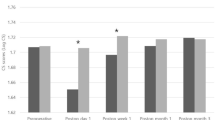Abstract
Purpose
To evaluate monocular accommodation changes after strabismus surgery with and without anterior ciliary vessel preservation.
Methods
Sixty patients with horizontal concomitant strabismus who were scheduled to undergo monocular strabismus surgeries were randomly divided into two groups: A (without anterior ciliary vessel preservation) and B (with anterior ciliary vessel preservation). Group A was further divided into groups A1 (surgical eyes without anterior ciliary vessel preservation) and A2 (corresponding nonsurgical eyes). Group B was further divided into groups B1 (surgical eyes with anterior ciliary vessel preservation) and B2 (corresponding nonsurgical eyes). Monocular accommodative amplitude (AA) and accommodative facility (AF) were evaluated before and 1 day after the surgery to assess accommodation.
Results
In groups A2, B1, and B2, the AA and AF values showed no significant difference preoperatively or postoperatively. However, compared with preoperative values, both the postoperative AA and AF values were significantly reduced in group A1.
Conclusion
Strabismus surgery without anterior ciliary vessel preservation reduces monocular accommodation, whereas strabismus surgery with anterior ciliary vessel preservation protects accommodation.

Similar content being viewed by others
References
Wilcox LM, Keough EM, Connolly RJ, Hotte CE (1980) The contribution of blood flow by the anterior ciliary arteries to the anterior segment in the primate eye. Exp Eye Res 30:167–174
Olver JM, Lee JP (1989) The effects of strabismus surgery on anterior segment circulation. Eye 3:318–326
Wright KW, Lanier AB (1991) Effect of a modified rectus tuck on anterior segment circulation in monkeys. J Pediatr Ophthalmol Strabismus 28:77–81
Simon JW, Grajny A (2004) Anterior segment ischemia following augmented 2-muscle transposition surgery. J AAPOS 8:586–587
Simon JW, Price EC, Krohel GB, Poulin RW, Reinecke RD (1984) Anterior segment ischemia following strabismus surgery. J Pediatr Ophthalmol Strabismus 21:179–185
Saunders RA, Phillips MS (1988) Anterior segment ischemia after three rectus muscle surgery. Ophthalmology 95:533–537
Mckeown CA, Lambert HM, Shore JW (1989) Preservation of the anterior ciliary vessels during extraocular muscle surgery. Ophthalmology 96:498–507
Oltra EZ, Pineles SL, Demer JL, Quan AV, Velez FG (2015) The effect of rectus muscle recession, resection and plication on anterior segment circulation in humans. Br J Ophthalmol 99:556–560
Velez FG, Davila JP, Diaz A, Coradetti G, Sarraf D, Pineles SL (2018) Association of change in iris vessel density in optical coherence tomography angiography with anterior segment ischemia after strabismus surgery. JAMA Ophthalmol 136:1041–1045
Pan M, Yang M, Xie R, Zhao Z, Huang X (2017) Does the disruption of horizontal anterior ciliary vessels affect the blood–aqueous barrier function? Graefes Arch Clin Exp Ophthalmol 255:2451–2457
Nilsson SF, Linder J, Bill A (1985) Characteristics of uveal vasodilation produced by facial nerve stimulation in monkeys, cats and rabbits. Exp Eye Res 40:841–852
Johnson MS, Christiansen SP, Rath PP, Watanabe TM, Merten G, Bothun ED, Anderson JS (2009) Anterior ciliary circulation from the horizontal rectus muscles. Strabismus 17:4
Acknowledgments
We thank Editage (www.editage.cn) for its linguistic assistance during the preparation of this manuscript.
Funding
This study was funded by National Natural Science Foundation of China (nos. 81670884 and 81873684), Medicine and Health Science and Technology Plan Projects of Xiamen City (no. 3502Z20194068), and Huaxia Translational Medicine Fund for Young Scholars (no. 2018-E-002).
Author information
Authors and Affiliations
Corresponding author
Ethics declarations
Conflict of interest
The authors declare that they have no conflict of interest.
Ethics approval
All procedures performed in studies involving human participants were in accordance with the ethical standards of the Xiamen Eye Center Ethic Board and with the 1964 Helsinki Declaration and its later amendments or comparable ethical standards.
Consent to participate
Informed consent was obtained from all adult participants, and parental permission and assent was obtained for all participants below 18 years.
Additional information
Publisher’s note
Springer Nature remains neutral with regard to jurisdictional claims in published maps and institutional affiliations.
Rights and permissions
About this article
Cite this article
Xie, R., Wang, Y., Pan, M. et al. Accommodation changes after strabismus surgery due to anterior ciliary vessel disruption. Graefes Arch Clin Exp Ophthalmol 259, 527–532 (2021). https://doi.org/10.1007/s00417-020-04905-3
Received:
Revised:
Accepted:
Published:
Issue Date:
DOI: https://doi.org/10.1007/s00417-020-04905-3




